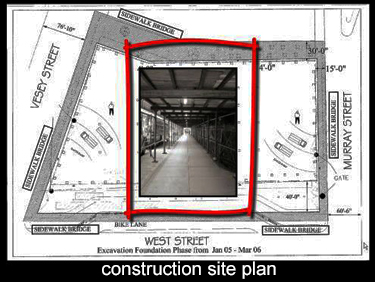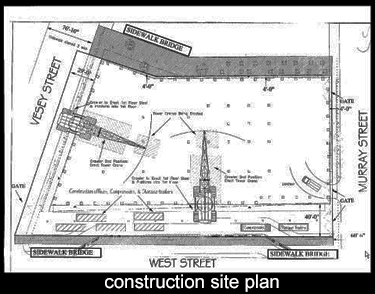This is a site plan, which has been developed for the project. It is a critical planning tool, because moving material in and out of the construction area is really critical to the success of the building. A good deal of time has to be spent dealing with the logistics of supplying the building, moving men and material in and out and doing this in a very crowded public environment, which means you need to interact with the adjoining streets and the adjoining pedestrian traffic. This requires a great deal of study and a series of drawings, which will define exactly how the site will be organized.
These drawings reflect the earliest condition, just the very beginnings of excavation and construction of the foundation. They've located a primary gate on both ends of the project, and that's how construction traffic will move in and out. They've also circled the project entirely with sidewalk bridges to protect the public.
Another critical early action item are utilities. You need to identify the needs of the building as quickly as possible, and coordinate with the utility companies, both public and private, to determine exactly what is required to service the new building. This has to be the most critical early design activity. It's a time-consuming activity, especially when you include the permitting and approvals. The entire schedule can be wrecked if this is not addressed at the earliest possible time.
 You've all walked under sidewalk bridges, but maybe you didn't know the term sidewalk bridges. Obviously, it's a means of protecting the public from any falling debris. The workers at the site need to be trained and supervised very carefully about leaving objects alone, which will become wind-borne and wind up down in the street. In spite of the close attention to these details, occasionally, things do get away and they find their way down. The job of the sidewalk bridge is to provide a safe space for the pedestrians, but it's only intended for really minor debris. It certainly could not stop a heavy load.
You've all walked under sidewalk bridges, but maybe you didn't know the term sidewalk bridges. Obviously, it's a means of protecting the public from any falling debris. The workers at the site need to be trained and supervised very carefully about leaving objects alone, which will become wind-borne and wind up down in the street. In spite of the close attention to these details, occasionally, things do get away and they find their way down. The job of the sidewalk bridge is to provide a safe space for the pedestrians, but it's only intended for really minor debris. It certainly could not stop a heavy load.
 Here is a later stage, and it shows some crawler cranes. The project will be serviced with the crawler cranes and backhoes and a number of pieces of equipment during the construction of the foundation. But this is a study of how the crawler cranes will eventually install the tower cranes. At some point, when the foundation is complete or substantially complete, the crawler cranes and all of that material on the ground will be replaced by tower cranes. This requires very careful planning. That was the purpose of this drawing. It also organizes some of the temporary storage devices on the project; compressors, storage trailers and even temporary field offices. That's all organized on this drawing.
Here is a later stage, and it shows some crawler cranes. The project will be serviced with the crawler cranes and backhoes and a number of pieces of equipment during the construction of the foundation. But this is a study of how the crawler cranes will eventually install the tower cranes. At some point, when the foundation is complete or substantially complete, the crawler cranes and all of that material on the ground will be replaced by tower cranes. This requires very careful planning. That was the purpose of this drawing. It also organizes some of the temporary storage devices on the project; compressors, storage trailers and even temporary field offices. That's all organized on this drawing.
 This later drawing shows the tower cranes already in place. This is really during the construction of the superstructure. There are several tower cranes that will be used, and they are mounted internally, which is to say, they climb on the steel frame of the building as it goes up. Obviously this has to be carefully worked out. The locations have to be coordinated with the framing of the structure, and locations have to be determined where every corner of the building can be serviced by a crane. There's also a need to pump the concrete. That space has to be dedicated, and it needs to be easy access by the concrete trucks.
This later drawing shows the tower cranes already in place. This is really during the construction of the superstructure. There are several tower cranes that will be used, and they are mounted internally, which is to say, they climb on the steel frame of the building as it goes up. Obviously this has to be carefully worked out. The locations have to be coordinated with the framing of the structure, and locations have to be determined where every corner of the building can be serviced by a crane. There's also a need to pump the concrete. That space has to be dedicated, and it needs to be easy access by the concrete trucks.